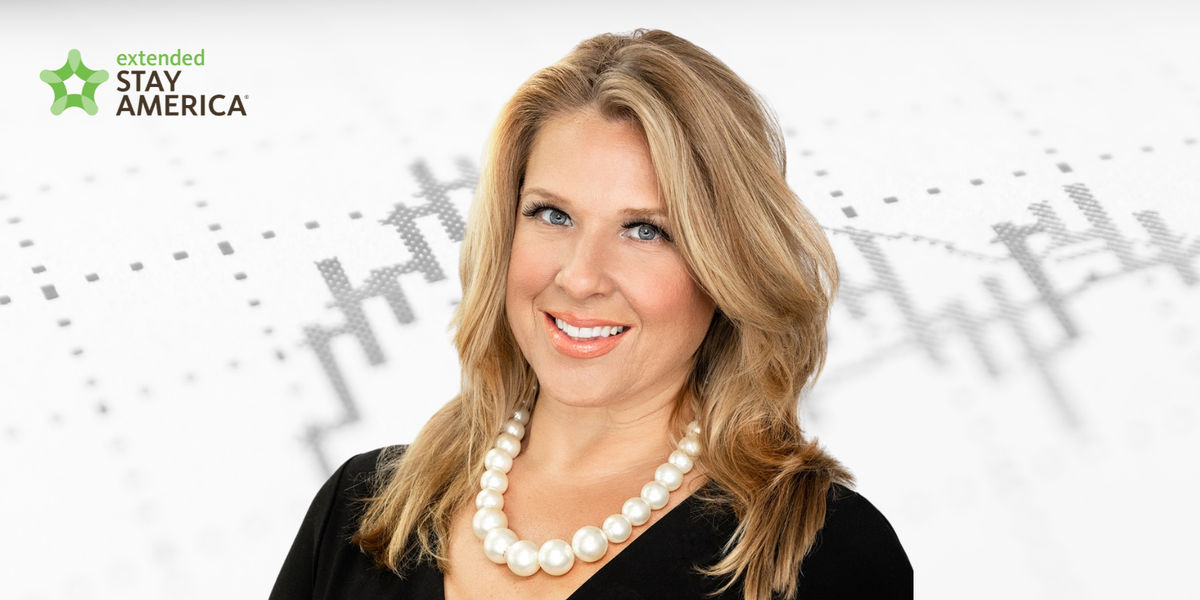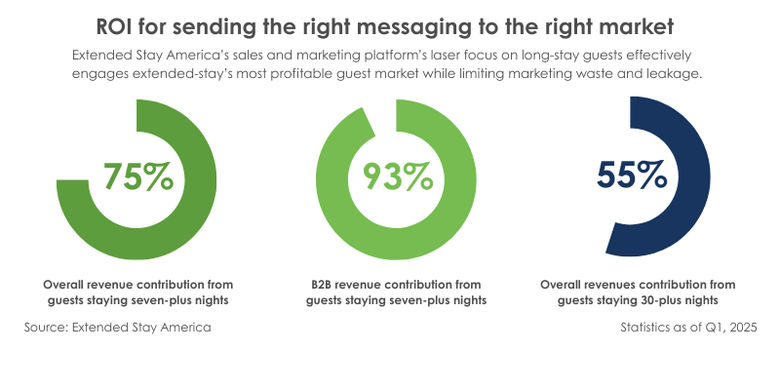Extended Stay America matches sales, marketing tactics to 2025’s trends

CHARLOTTE, North Carolina ‒ Extended-stay hotel brands’ sales and marketing programs have to do more than put heads in beds to help franchisees navigate 2025’s up- and downsides, according to Kelly Poling, executive vice president and chief commercial officer, Extended Stay America (ESA).
“Based on the first quarter, 2025 is likely to be a year of uncertainty,” she said. “Fortunately, lessons learned across 30 years of cyclical highs, lows and a pandemic make ESA well-positioned to weather the storm. As owners ourselves, we understand the importance of a sales and marketing program that can create opportunities and control costs in any market. Our commercial platform gives us a lot of levers to pull.”
Driving long-stay demand
That starts with what Poling describes as this segment leader’s “100% focus” on sales and marketing outreach specifically targeted to increasing stays of seven nights or longer.
“Every decision we make is filtered through the lens of whether it will increase true extended-stay demand,” Poling pointed out. “For example, we conduct research among guests who book stays of 10 nights or more. We offer an affordable rate structure that rewards guests for longer stays. Our Extended Perks membership program offers rewards and discounts with the unique needs of extended stay guests in mind.

On-target sales and marketing drive growth in the overall extended-stay guest market as well as among travelers seeking out one of ESA’s segment-spanning brands.
Unlike traditional hotel brands that realize single-digit contributions from their extended-stay brands, 75% of ESA’s revenues come from guests staying seven-plus nights. For B2B business, that metric jumps to 93%. “The fact that extended stay is our only business allows us to get better and better at it. This is our competitive advantage,” said Poling.
Prioritizing length of stay is integral to ESA’s track record for outperformance, especially in a fluctuating market. “The combination of industry-leading occupancy and a high percentage of long-stay business create significantly more consistency and predictability in top-line revenues than other models,” said Poling.
Monetizing diverse demand
Doubling down on targeted consumer research gives Poling and her team more ways to leverage the diversity in long-stay demand across market conditions.
“Many people in the industry treat extended stay as one broad market that groups all customers into one bucket. Having spent 30 years in this space, ESA understands incredibly well why it isn’t,” said Poling.
A deeper dive into the varied segments within the extended-stay category revealed untapped opportunities for two brands to sit alongside the core Extended Stay America Suites brand. Premier Suites answers demand from long-stay travelers willing to pay higher rates for an elevated experience. The Select Suites flag targets long-stay customers willing to forego some non-essentials to get a lower price point.
ESA’s data-driven approach to its commercial platform gives sales teams the tech tools to micro match groups within the company’s guest database with opportunities that emerge in specific hotel markets.
“Depending on the location we can pull the traveling nurse lever, the construction worker lever or the project management lever. We can tailor messaging by travel occasion, price point or length of stay,” said Poling. “We know from our brand research that our Premier Suites audience is more interested in an elevated breakfast offering. They will pay a higher rate to get a larger TV and upgraded bedding. But our Select Suites guest would rather not pay for breakfast and get a lower rate. They don’t want to have to cover the cost of a 24/7 front desk as long as they can get help when they have questions.
That in-depth customer knowledge informs tightly focused messaging that limits waste and leakage. Client-targeted sales and marketing incorporate key words and promotional offers that reflect guests’ input. Franchisees see more of their fees channeled into initiatives that reach their most impactful customers, according to Poling
“Using data and AI, we not only help franchisees maintain segment-leading occupancy, we also help them reach targets that are most likely to optimize rate and RevPAR,” Poling pointed out.
Growing revenue while controlling costs
Rate growth and increased pull-through are also pillars in ESA’s commercial platform. Even these expected goals got a new spin based on the company’s experience owning the majority of its 700 hotels.
“We don’t have to sympathize with our franchisees; we can empathize with them because we’re owners, too,” said Poling. “As a result, we pay closer attention to revenue profitability than many of our competitors. We are laser-focused on driving revenue through our contact center, our website and our new mobile app.”
We don’t have to sympathize with our franchisees; we can empathize with them because we’re owners, too.
Kelly Poling, Extended Stay America
Initiatives like these reduce reliance on expensive third-party contributions. Now, the typical ESA owner gets 60% of their revenue from the proprietary Extended Stay America web site and contact center. “That’s roughly twice that of our closest competitor,” said Poling.
ESA’s Extended Perks membership program is a major factor in achieving those results. Like every other element in the company’s business model, this program was custom-designed to give long-stay guests bottom-line benefits.
“Research revealed that discounts on hotel rates and discounts on products and services from thousands of partners would motivate our customers to join our membership program. Points-based, tiered or status-based rewards would not,” Poling said.
ESA streamlined its membership offer to give all members the same access to savings and other benefits. Logging into their account also reveals special offers and opportunities to win discounts.
Poling and her team pulled through these wins to the franchisee and corporate P&Ls. This unique structure addresses two key points that matter most to owners: there’s no cost to franchisees, and members can get the best rates exclusively on ESA’s proprietary channels, which drives cost-effective direct bookings.
“We and our franchise owners get all the good things associated with membership programs without all the stuff owners hate regarding the costs of points-based loyalty and complicated earn-and-burn points-related programs,” Poling said. “Our Perks members currently generate 45% of all company revenue. That’s magical.”
Creating next-cycle sales, marketing strategies
The goals of driving long-stay demand as well as revenue and operational profitability will shape the initiatives Poling and her team have on their docket.
She’s already testing additional website functionality to set up the booking process as if the customer was considering an ESA hotel versus an apartment. “This is a searching and booking modality that feels more like an apartment website because that’s what our guest is comparing us against,” said Poling.
“Our proprietary contact center delivers 30% of our revenue so we’re going to improve it to make sure we are driving rate and constantly increasing the conversion and revenue per call.” ESA is also enhancing its value proposition to B2B accounts and to increase our clients’ “stickiness,” Poling noted.
Continued emphasis on relationships will remain a priority, she added. “Every client who works with our B2B team talks about how engaged their salesperson is, how they help fill business gaps, address service issues and makes sure every guest has the best possible experience. ESA doesn’t act like a corporate behemoth. We want our passion and genuine caring for our owners and guests to be our differentiator.”
Mary Scoviak is custom and design content director for Hotel Investment Today by Northstar.
The views and opinions expressed in this content do not necessarily reflect the opinions of Hotel Investment Today by Northstar or Northstar Travel Group and its affiliated companies.
link






